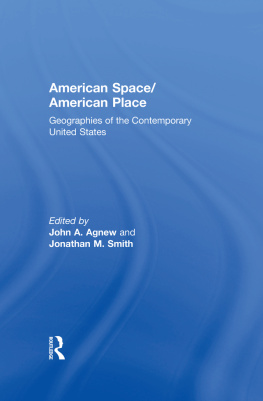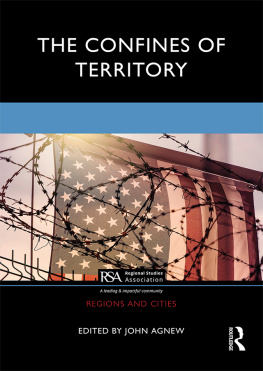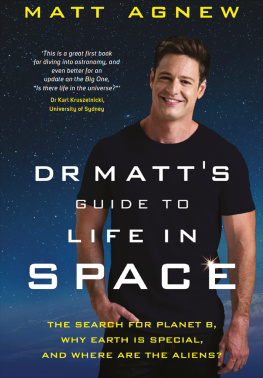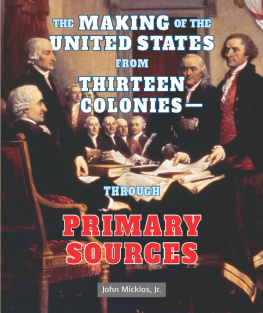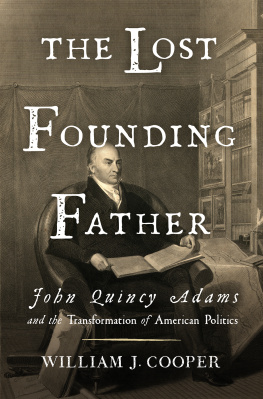Published in 2002 by
Routledge
711 Third Avenue, New ork, NY 10017, USA
Routledge is an imprint of the Taylor & Francis Group, an informa business
editorial matter and organization John A. Agnew and Jonathan M. Smith, 2002
the chapters of the various contributors, 2002
Published by arrangement with
Edinburgh University Press, Edinburgh, in 2002.
Typeset in Goudy Old Style and Gill Sans Light
by Pioneer Associates, Perthshire
All rights reserved. No part of this book may be printed or utilized in any form or by any electronic, mechanical or other means, now known or hereafter invented, including photocopying and recording, or any other information storage or retrieval system, without permission in writing from the publisher.
Library of Congress Cataloging-in-Publication Data is available from the Library of Congress.
Agnew, John and Jonathan Smith
American space/American place: geographies of the
contemporary United States / edited by John Agnew and
Jonathan Smith
ISBN 13: 978-0-415-93531-9 (hbk)
In 1941 American magazine magnate Henry Luce wrote and published The American Century, a patriotic essay stating what would soon become the popular view of the nation's destiny. His immediate purpose was to urge American entry into the Second World War, an adventure then opposed by about 80 percent of the American population, but his ultimate goal was to change the way Americans understood their place in the world. America's participation in the war was to be simply the first step toward taking its proper role in world affairs, toward assuming its full responsibilities and entitlements as global hegemon. Expressing what would become the standard interpretation of American history between 1918 and 1941, Luce wrote:
In the field of national policy, the fundamental problem with America has been, and is, that whereas their nation became in the 20th Century the most powerful and most vital nation in the world, nevertheless Americans were unable to accommodate themselves spiritually and practically to that fact. Hence they have failed to play their part as a world power a failure which has had disastrous consequences for themselves and for all mankind. (Luce 1941: 22-3)
The disaster for all mankind was the rise of expansionist totalitarian states and the global war that necessarily resulted. The disaster for Americans was a spiritual malaise brought on by their indecision. Americans did not know what to do, Luce contended, because they would not decide what to do; they dreaded the future because they lacked the will to shape the future into something more to their liking.
Luce's essay called for completion of the half-accomplished fact of American hegemony, with ensuing benefit to the world and the United States. America's gift to the world was to have four parts. It would guarantee free trade, and thereby promote prosperity. It would train the world's technocrats, and thereby promote progress. It would distribute aid, and thereby alleviate want. It would promulgate the ideals of liberty and democracy, and thereby ennoble mankind. In return for these gifts, it would recover the sense of unique purpose and mission that is necessary to American national identity.
A half century later it seemed that much in this vision had become reality, and that "a truly American internationalism" had become for many Americans and non-Americans "as natural... as the airplane or the radio" (Luce 1941: 26). Americans did accommodate themselves, spiritually and practically, to playing the part of a world power, shaping the "world-environment" to their own advantage and, many believed, the advantage of others (Luce 1941: 24). The popular mood in many quarters of the United States was, indeed, triumphal at century's end, with the collapse of the USSR (1989), the swift victory in the Gulf War (1991), and the long economic boom and technological revolution of the 1990s following one another in quick succession. The twentieth century appeared to have been the American Century after all, or, as more than a few ebullient observers insisted, the First American Century. In 1989 then president George Bush spoke of a New World Order that differed hardly at all from the "vital international economy" and "international moral order" championed by Luce (Luce 1941: 25).
This spectacle of America's triumph had at the same time, for many observers, a curiously unreal and evanescent quality. It seemed impermanent, like so many of the buildings springing up beside American expressway interchanges. It seemed illusory, like so many of the public personalities and synthetic experiences booming in the electronic media. More than a few writers noted its resemblance to a theme park. But above all else, it seemed inflated. Historian John Lukacs has taught us that inflation is not limited to the money supply, but can occur to the supply of anything when that supply increases more rapidly than the supply of other things to which it had traditionally stood in some sort of significant relation (Lukacs 1970). There is no denying that this is often desirable, as when improved productivity leads to inflation in the supply of food, health, education, and useful consumer goods, to reduced prices and wider distribution of such goods. But such inflation is also confusing because these goods no longer mean what they once meant as symbols of status or indicators of individual and collective achievement. Less desirable but no less confusing is inflation in the supplies of symbolic goods such as high marks for students, titles and degrees, encomiums, and the language (hyperbole), which was vigorous in the late twentieth-century United States. To take but one example, it was difficult to judge just where American education stood after the vast inflation of high school graduates, from 25 percent of the population in 1940 to 82 percent in 1996.
Skepticism over the apparent successes of the American Century was in many cases legitimated and amplified by a critical attitude that originated in radical political movements of the 1960s and subsequently spread to the universities and the media. These institutions popularized the critical attitude, particularly among the rising generation, and abetted the decline in public trust in authority. The terrorist attacks of 11 September 2001 encouraged both a sense of the limits of American power and a rallying around the flag.
Skepticism and a critical attitude explain only part of the outlook of those who doubted whether the United States had ended the century in an unequivocally triumphant position. There were also unsettling changes in the nation itself. Deep, disruptive, and highly controversial changes were underway in social structure (especially the family), culture (especially attitudes toward sex and work), and the economy (especially deindustrialization and the shift to finance and service-sector employment). Although they were concerned by different aspects of these changes, and drew from them very different lessons, critics on both the left and right publicly worried over their implications. It was in this mixed atmosphere of triumph and trepidation that this book was originally conceived, as a geographical analysis of the United States at the end of the American Century and the beginning of a century that awaits its name. Recent changes in the actual geography of the United States have been momentous, but they are in most cases background to these essays, not the substance. Thus you will not find chapters on mass suburbanization, the urbanization of the intermontane West, or the settlement patterns of recent immigrants, important and interesting as these matters are. What you will find are essays that describe the ways in which geography has affected the way that Americans understand themselves and the part they are to play in world affairs. The goal in this book is to approach changes in actual geography by way of changes in imagined geography, by way of changes in the American geographical imagination.


